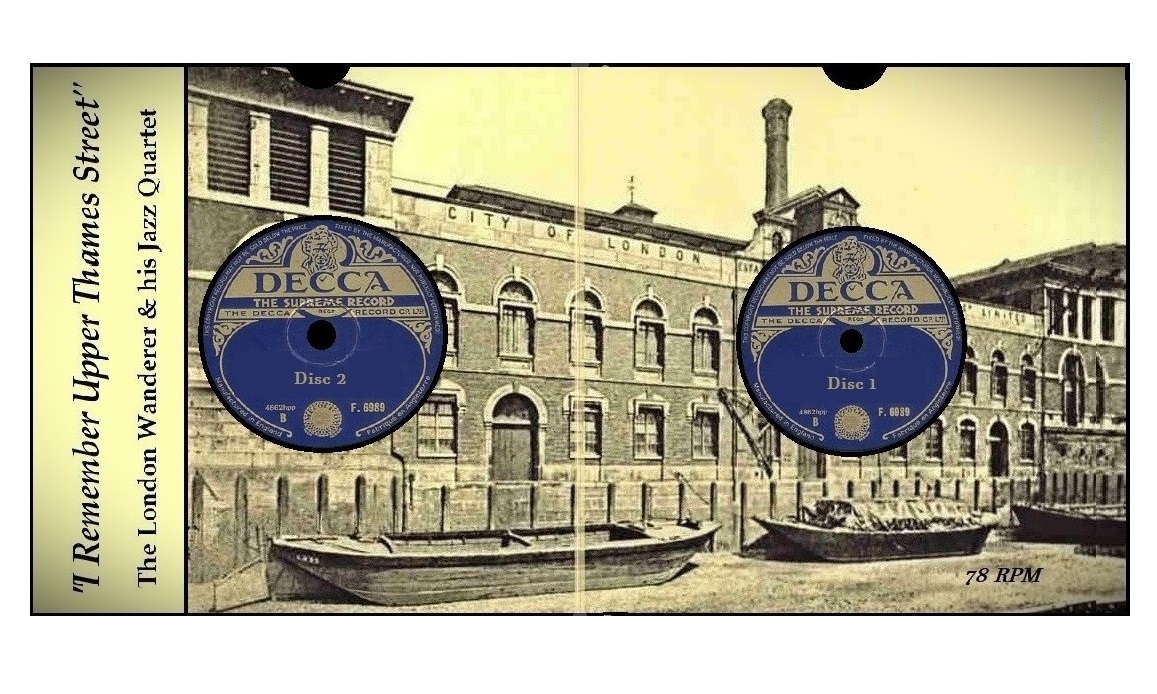
The Square Mile is not the sort of place one associates with recording studios. International finance, yes. Archaic ceremony, yes. Bewilderingly obscure governance, absolutely. But microphones and sound booths? No. Yet Decca – the company that famously rejected the Beatles – once had their main studios on Upper Thames Street, not far from London Bridge.
To tell the story of this bizarre, short-lived City aberration I must first go back more than 400 years, to Mr. Pott and his brewhouse.
Breweries and Big Houses
On the north bank of the Thames, just to the east of where we now find Cannon Street Station, was once a neighbourhood known as Coldharbour. This is remembered mainly for a large mansion of the same name, which – rebuilt many times – stood in the area from the 13th century until well into the 18th. However, even before the Great Fire of 1666 the area had become rundown and crime-ridden, described by one commentator as a ‘sanctuary for debtors and vagabonds‘. Thomas Nashe, writing in 1596, implied people could disappear simply by taking rooms in Coldharbour because of the ‘continuall myst, betwixt two brewhouses’.
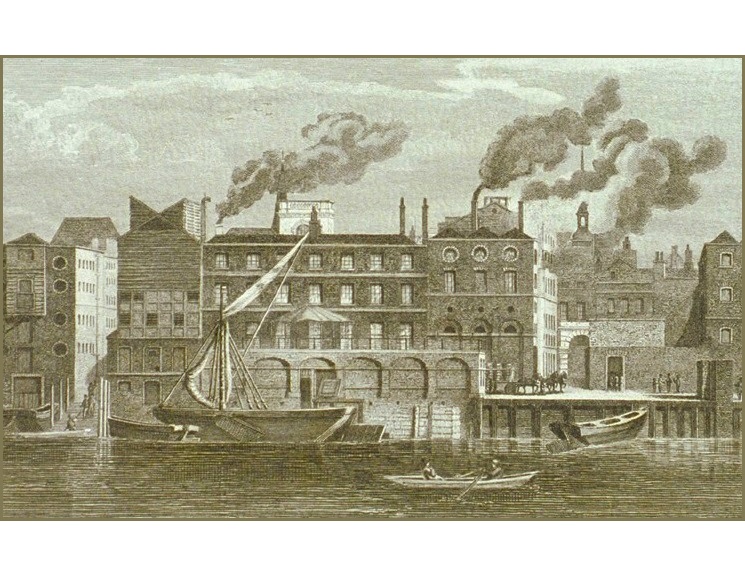
It is no surprise that a longstanding Coldharbour landmark was a brewery – a malodorous facility that would be unwelcome in more genteel areas. The Hour Glass brewery had been founded, according to Elizabethan historian John Stow, by a Mr Pott in Hay Wharf Lane. Destroyed in the Great Fire, it was rebuilt, then bought by Sir William Calvert – both Lord Mayor and MP for the City – in the mid-18th century. Rebuilt again on an enlarged site after a fire in 1805, it was acquired in 1861 by a new enterprise, the City of London Brewery Company.
← Calvert’s brewery from the Thames, early 19th century. The site stretched back from the wide river frontage for around 100 metres, its address usually given as 89, Upper Thames Street.
In 1895 the brewery was rebuilt again, this time covering almost all of Coldharbour. ‘Almost’ because this wasn’t a regular plot of land, as the area had once contained not one but two parish churches. All Hallows the Great had recently fallen victim to road-widening, but its tower, vestry and churchyard survived. All Hallows the Less – built above the gateway to the old mansion – had been destroyed in the Great Fire but its site was now a garden, with an old graveyard watch-house. The brewery had to be built around these still-hallowed obstacles.
The unwieldy site was not the only problem the Hour Glass faced. The brewing process needs plenty of water, and inevitably this had to be drawn from wells rather than the adjacent filthy river. The problem was that a rival brewer on the opposite bank of the Thames used the same technique, and the story goes that when one pumped water, the levels in its rival’s wells would fall to unusable levels.
Perhaps partly due to this, but more probably due to the site’s rising value as development land, the sands of time were running out for the rebuilt Hour Glass. The company bought alternative facilities elsewhere, and brewing at Upper Thames Street ended in 1922 after around four centuries. However, the hoped-for purchaser didn’t materialise so instead the buildings were refurbished to be let as wharves, wharehousing and offices. The brewery tap – the Hour Glass pub – survived the closure of the brewery and continued serving beer as new tenants moved in around it. By 1927, with Britain in an economic depression, the desperate brewery company was prepared to adapt unlet areas for any use prospective tenants might require. Companies tempted included Chappel Brothers, US manufacturers of dog food, Thames Garage, a car and van dealership, and Armita, suppliers of tweed suits. Part of the site was even converted into ‘City flatlets’ for rent. Among this eclectic group of tenants – and no doubt ill-at-ease amid the dog food and used charabancs – was the British Broadcasting Corporation.
London Calling
In 1923 the BBC, in its infancy and with just a handful of employees, had moved into an office block on Savoy Hill next to the Savoy Hotel, a mile west of the brewery. Its exponential growth over the next decade led it to take whatever space it could find in nearby buildings. At the under-utilised 89 Upper Thames Street, it created the Thames Street Studio, a rehersal space for the orchestras and bands that were a staple of its early broadcasts. As the studio was on an upper floor, larger musical instruments had to be hoisted up, probably using the old brewery winches. However, the Corporation didn’t have to go through that palaver for very long. The studio became redundant when, in 1932, Auntie Beeb waved goodbye to Savoy Hill, its environs and this narrative, and said hello to the brand new, purpose-built Broadcasting House on Portland Place.
Enter a Financial Basket Case
Gramaphone manufacturer Decca moved into record production in the 1920s just as – it seemed – the smart money was moving out: Investors feared the impact of BBC radio broadcasts on the demand for ’78s’. Ultimately, Decca’s move was a success, but initially it staggered from one financial crisis to another, hindered by the poor quality of its recording studio at Chenil Galleries in Chelsea, west London. The search for better facilities finally lighted on the former BBC premises. Decca took possession in 1933, and 89 Upper Thames Street became its main recording studio a year later. Over the next four years it hosted some very famous faces:
Jerome Kern directed the soundtrack recording of his final collaboration with Oscar Hammerstein II, the Drury Lane musical Three Sisters. Henry Wood, founder of the Proms, with his Queens Hall Orchestra recorded various classical pieces. The London Symphony Orchestra did likewise, and the BBC returned to record some Gilbert & Sullivan, along with some choral music featuring Peter Pears. Stephane Grapelli and Django Reinhardt recorded some Jazz standards the day after a legendary gig near Cambridge Circus.
Possibly the most famous artists to use Thames Street were the Mills Brothers jazz quartet, well-known in their native US and newly signed to Decca. They recorded two songs in their unique style, mimicking various musical instruments as well as providing the vocals, with only a single real guitar for support. They subsequently became famous in Britain.
Thames Street’s downfall was caused by Decca’s 1937 purchase of a struggling rival, Crystalate. The jewel in the crown of this now-forgotten outfit was the former West Hampstead Town Hall in north west London, which Crystalate had converted into state-of-the-art recording studios. Thames Street closed in May 1938, never to reopen.
→ The Mills Brothers kick-started their British popularity with recordings made at Thames Street.
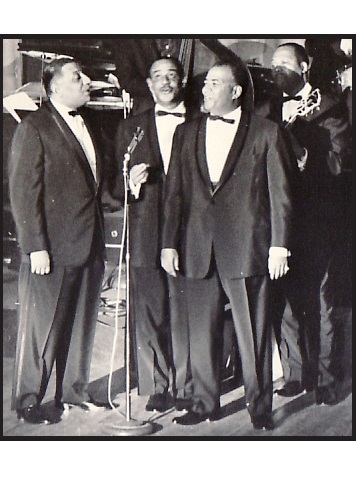
The Post-Decca Years
By mid-1940 the world was at war and part of the empty brewery had been converted into a mortuary for civilian casualties, with a grim roll-call of facilities – two mortuary rooms with viewing areas, personal effects room and wash room. Even the contract for these works was depressing; a clause stated that in the event of a national emergency, the contract could be terminated in writing by City authorities. Personally, I can’t imagine a City bureaucrat writing a formal letter of cancellation in the midst of an invasion.
The West Hampstead studio survived for forty years, and was the site of the Beatles’ failed audition, some Rolling Stones sessions and many other memorable moments. But had Decca not bought Crystalate, would Thames Street have been the location of these? Could it have become as famous as Abbey Road, the studio of Decca’s great rival EMI, and the Hour Glass pub the scene of legendary rock ‘n’ roll gigs and boozing? No. In September 1940 at the height of the Blitz incendiary devices damaged the complex and in 1941 much of the site – waterside warehouse, watch-house, brewery tap, mortuary, flatlets – was destroyed.
The few surviving buildings, patched up, staggered on amid the wasteland. At the end of the 1950s the brewery company finally sold up, and moves were made to clear the church graveyard. In the 1970s after years of planning, British Telecom built the gleaming white Mondial House, packed with cutting-edge telecommunications equipment. At least, it would have been cutting edge had it been completed on time in 1975. Instead, It opened in 1978 and only became fully operational a few years after that. Some said it looked like a spaceship or a Dansette record player; the then-Prince Charles memorably compared it to a word processor.
→ Mondial House from the Thames, near the end of its life.
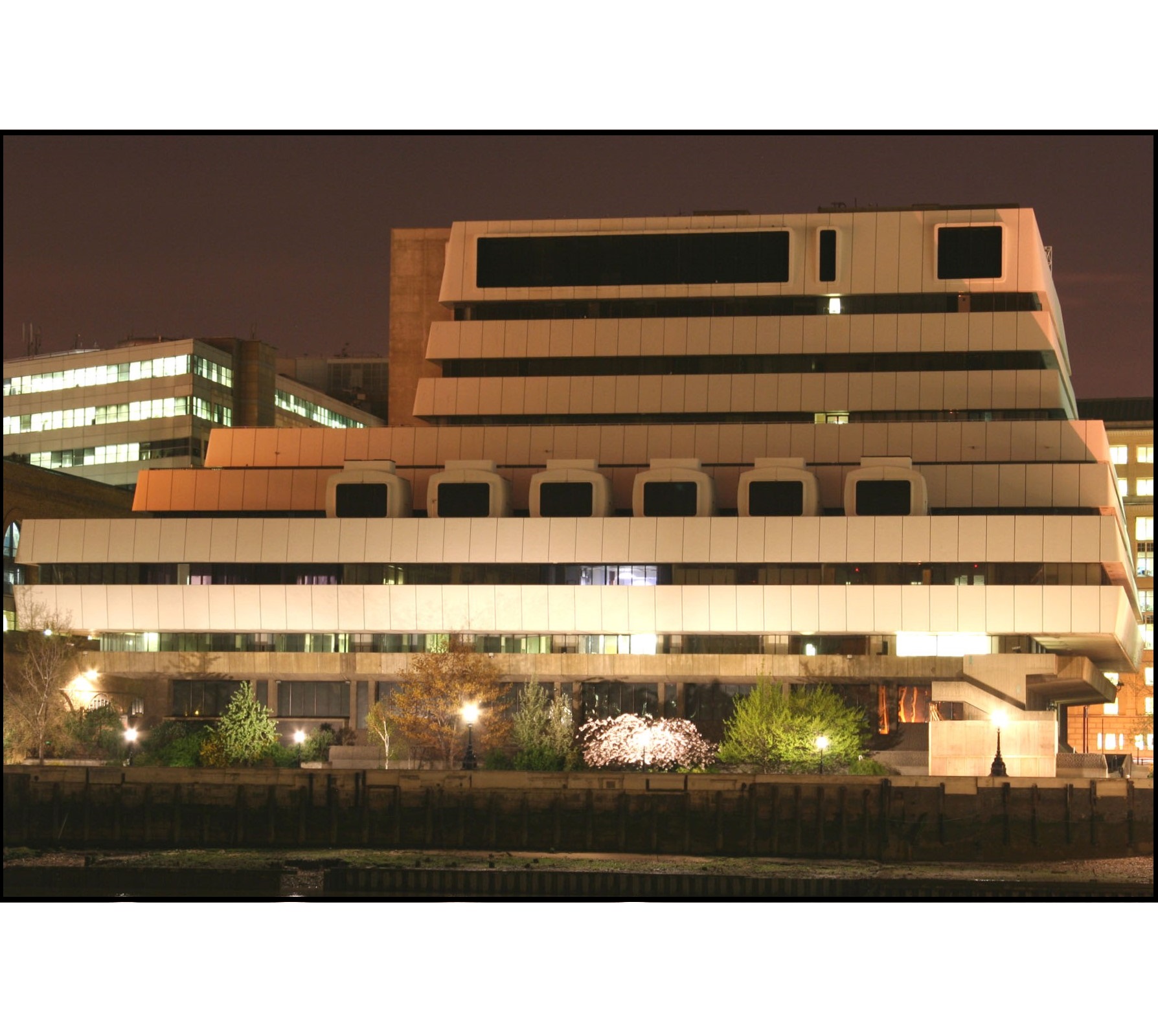
It didn’t last long. Mondial House was closed, its technology hopelessly outdated, in 2004. It was demolished soon after and Watermark Place, a glass-fronted office block, was built on the site using its predecessor’s foundations.
→ Watermark Place, centre, covers the site of the former brewery
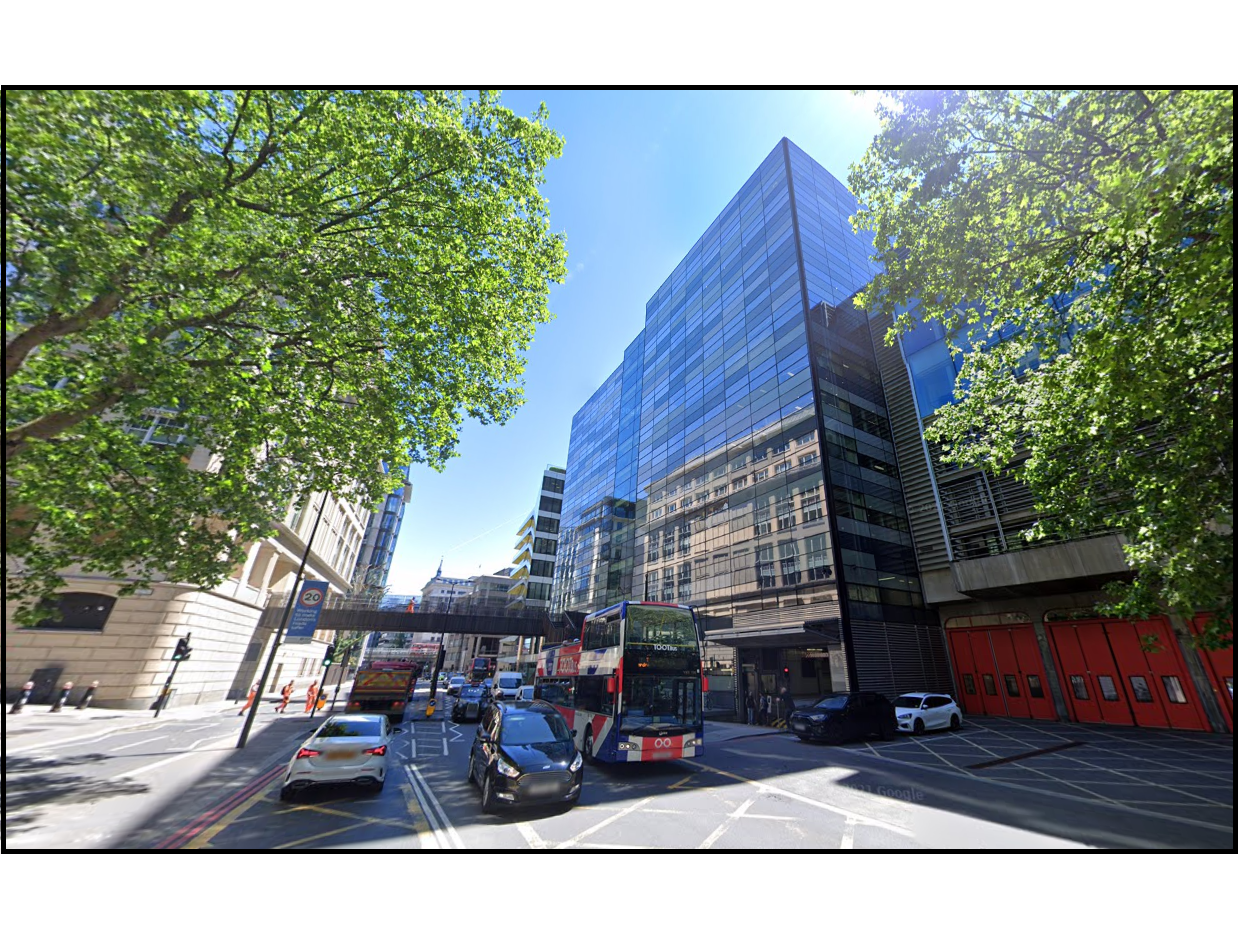
The City of London acquired modern facilities for the fire service with the 1978 development, and Dowgate Fire Station survived its sibling’s 2004 demise. The upper floors have been reclad but the ground and mezzanine floors betray its 1970s origin.
→ Dowgate Fire Station. It occupies the approximate site of All Hallows the Great tower, vestry and graveyard. The alley to the right is All Hallows Lane.
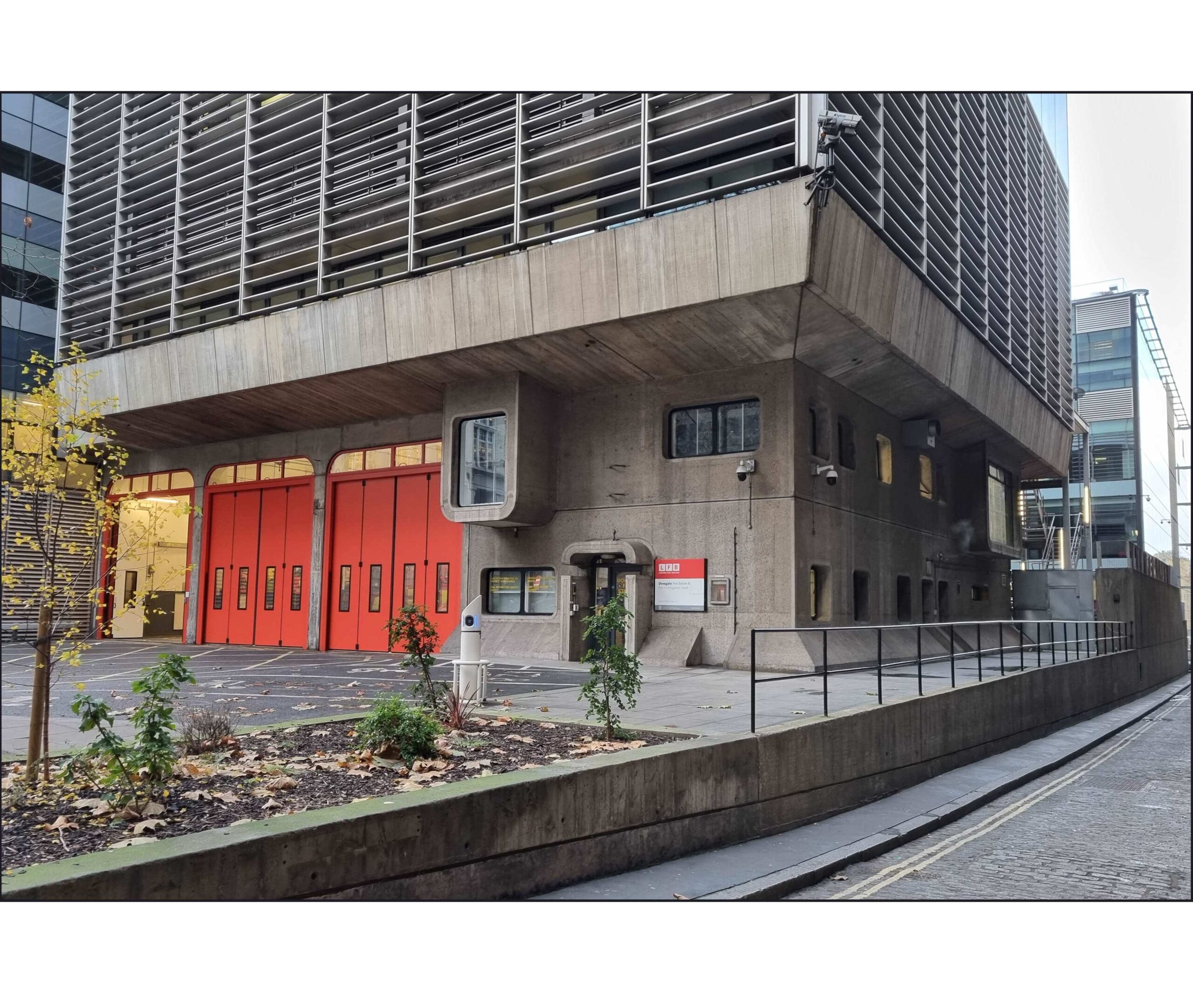
That’s a Wrap
Post-war, I’m not aware of any recording studios operating in the City but currently the closest is only about 100 metres north of its border. This is the eccentric Fiction Studios in, of all places, the elegant Georgian cul-de-sac Ely Place.
The main players in this tale are still with us, of course – the BBC, Decca (now part of Universal Music Group), even the City of London Brewery Company, despite having sold all its brewing interests. It reinvented itself as the City of London Investment Trust, and remains a constituent of the FTSE 250 share index. Pleasingly, one of its largest holdings is in Diageo, the brewing and drinks giant.

Nearest Station:
Credits:
Selected Bibilography: